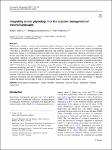Item Infomation
Full metadata record
| DC Field | Value | Language |
|---|---|---|
| dc.contributor.author | Tudor, Emily P. | - |
| dc.contributor.author | Lewandrowski, Wolfgang | - |
| dc.contributor.author | Tomlinson, Sean | - |
| dc.date.accessioned | 2023-08-04T03:15:36Z | - |
| dc.date.available | 2023-08-04T03:15:36Z | - |
| dc.date.issued | 2023 | - |
| dc.identifier.uri | https://link.springer.com/article/10.1007/s00267-023-01800-5 | - |
| dc.identifier.uri | https://dlib.phenikaa-uni.edu.vn/handle/PNK/8663 | - |
| dc.description | CC-BY | vi |
| dc.description.abstract | Global-scale ecological changes and intensifying habitat destruction and have caused alarming declines in wildlife populations, resulting in a great need for concerted efforts towards their conservation. Despite this, animals are frequently overlooked in restoration and management initiatives and therefore populations often do not reassemble following disturbance without re-establishing habitat that meets their abiotic and biotic requirements. However, restoration ecologists broadly lack insight into the physiological mechanisms that can govern the responses of fauna to environmental change and management. Therefore, we conducted a literature search for studies reporting a mechanistic understanding of faunal habitat suitability and selection in restored landscapes to deliver an updated perspective on the integration of animal ecophysiology and restoration ecology. | vi |
| dc.language.iso | en | vi |
| dc.publisher | Springer | vi |
| dc.subject | Global-scale ecological changes | vi |
| dc.title | Integrating animal physiology into the adaptive management of restored landscapes | vi |
| dc.type | Book | vi |
| Appears in Collections | ||
| OER - Khoa học môi trường | ||
Files in This Item:

